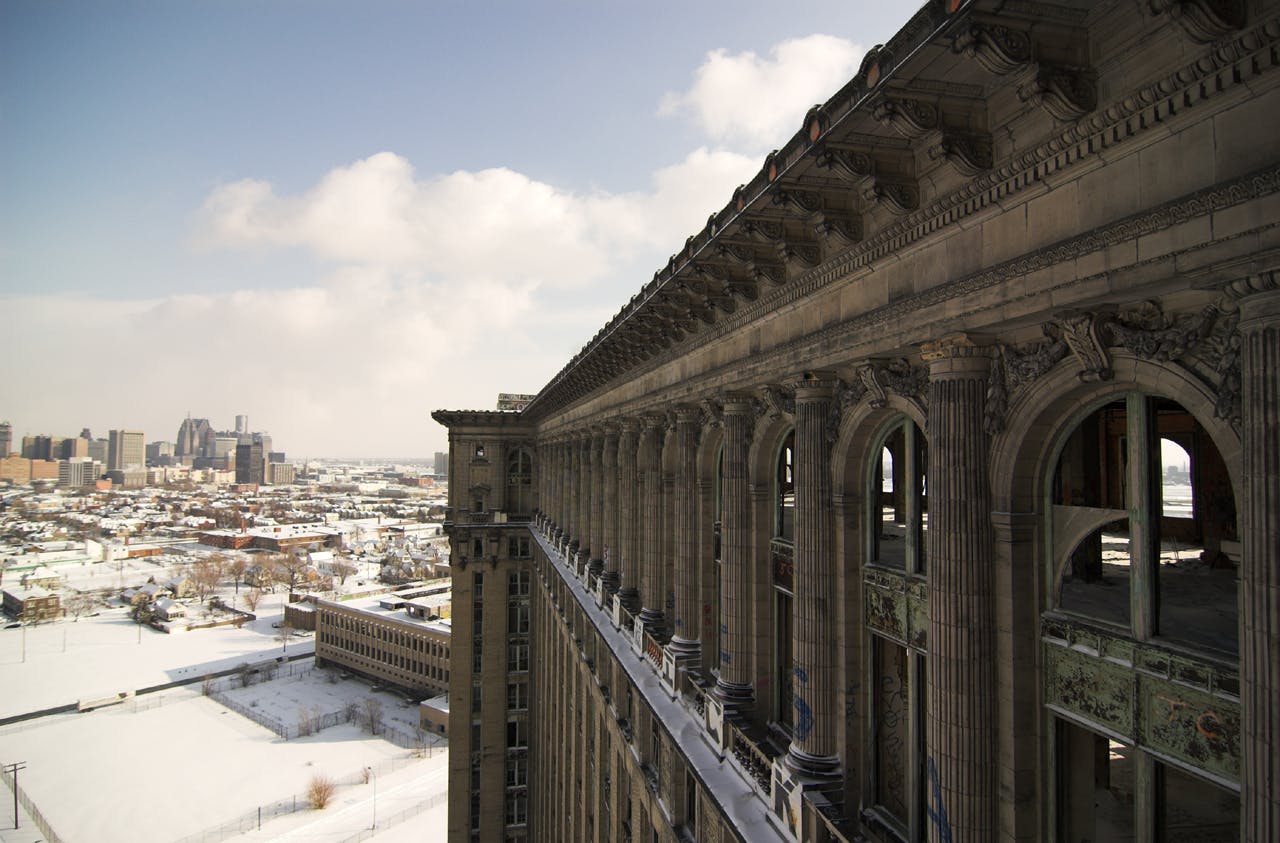It’s a freezing day in Detroit and once again Scott Hocking has found himself crossing a sheet of ice six feet deep in the basement of the abandoned Michigan Central Train Station. By this point it’s routine. Cross the Roosevelt Warehouse ice basement, crab walk the flooded underground tunnel, navigate the train station yard, watch out for security, climb eight flights of stairs, and you’ll see the reason for Hocking’s persistence. Here, arranged in the center of the hall, stand two tons of marble detritus, laboriously hand-gathered from the station’s destruction and carefully and respectfully configured into a monumentally delicate:
egg.
The ingenuity.

Scott Hocking, The Egg and Michigan Central Train Station #4764, 2012. Archival pigment print.
Like all of Hockings’ site-specific installations, the egg was designed to be photographed, to interact with its physical environment over time, and to provide a shockingly beautiful chance encounter for Detroit’s plethora of “urban explorers.”
Despite the difficult journey, many people found their way to the egg—a magical sight, I can only imagine. The contrast between the station’s underbelly and Hocking’s eighth floor installation is dramatic, terrifying, and dreamy. En route to the egg, Hocking would emerge from the underground tunnel, which was tagged the “haunted fuck hole,” dank with decades of neglected water, and frozen with layers of industrial waste and, as Hocking discovered, human remains. Symbolically, and with the cyclical passing of each winter’s frost and spring’s warmth, the egg was born upstairs. Eventually, it would be demolished, “cleaned up,” and returned to its original state of scattered marble wreckage, marking the end of Hocking’s project, and the early beginnings of the train station’s corporate rebirth.
The station is not only a part of Detroit’s rich, fraught, and controversial past and present, it is emblematic of it. News spread quickly throughout the city and nation this summer when Ford Motor Co. purchased the building after 30 years of vacancy and neglect. The building is over 100 years old, with construction beginning in 1912 under the architectural direction of Warren & Wetmore and Reed & Stem, the two firms that designed New York’s Grand Central Station. Michigan Central Station, like its New York counterpart, is elegant in design, grand in scale, powerful in material, and impressive in construction. Traditional midwestern modesty did not apply.
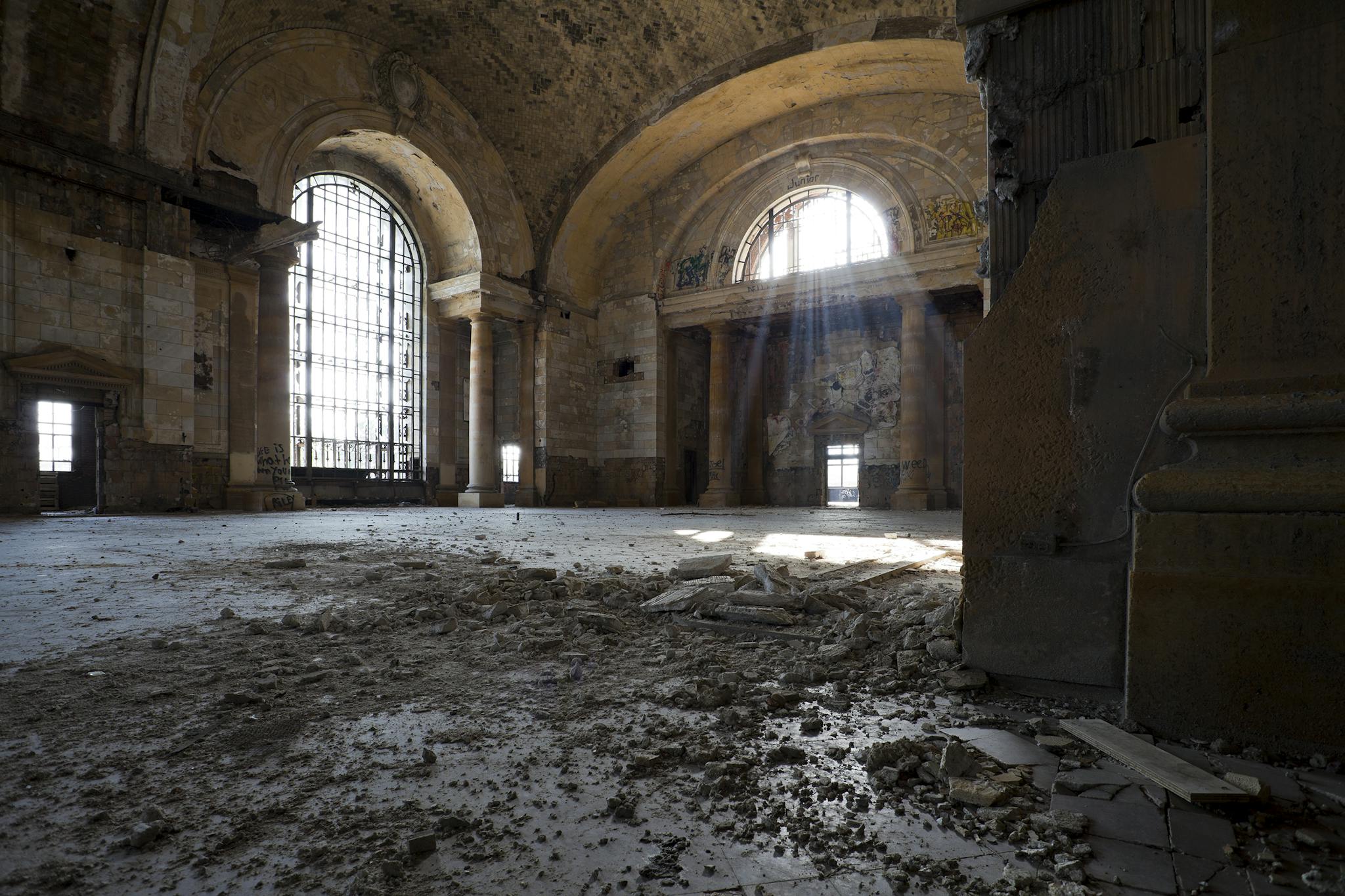
Scott Hocking, The Egg and Michigan Central Train Station #9036, 2011. Archival pigment print. // Morning light seeps into the Waiting Room, which features 80-foot ceilings modeled after Roman Baths.
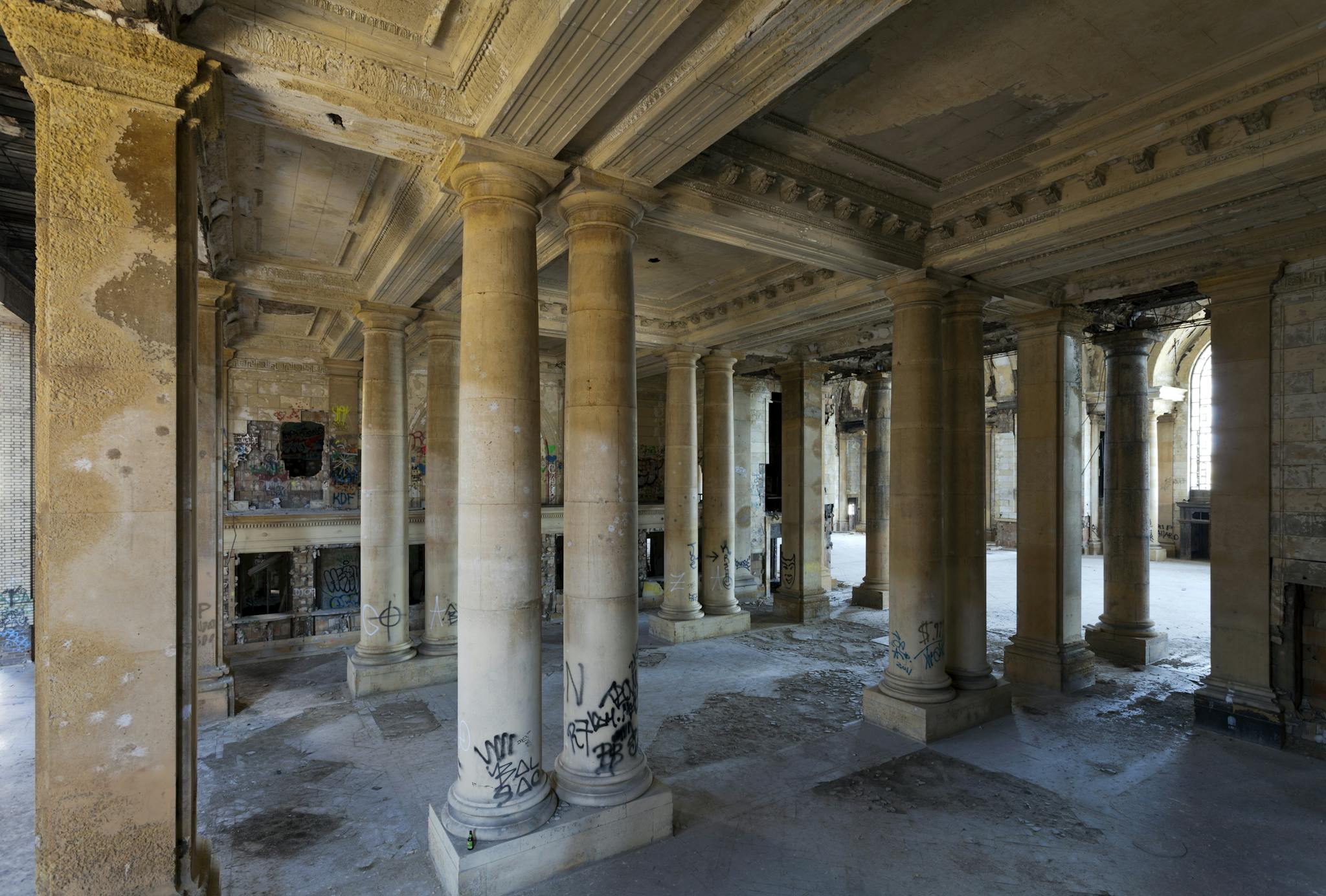
Scott Hocking, The Egg and Michigan Central Train Station #9452, 2011. Archival pigment print. // Columns line the ticket lobby between the station’s waiting room and concourse.
The station functioned smoothly from its opening in 1913 through the 1940s—a time when 4,000 passengers a day walked across its marble floors in the Roman bathhouse-inspired waiting room and 3,000 people worked in the office tower (in which 70 years later an enormous marble egg was lovingly erected on the eighth floor). But by the 1960s the amount of passengers was in steady decline due to affordable air travel and Detroit’s famous industrial contribution: the motor vehicle. With the birth of personal cars came the death of Detroit’s public transportation services, and by 1988 the last train left Michigan Central Station, headed for Chicago.
Over the next 29 years the station became a symbol for “The Tragedy of Detroit,” as the New York Times kindly headlined in 1990. Its abandon and ruin was a reflection of the city’s economic hardship and associated experience with institutionalized racism. The reverberations of this history are felt with great weight today. The resurgence of the white population returning to Detroit zip codes, business developments’ hefty, quick deals, and auto companies that initiated the demise of Detroit’s public transit and are now, ironically, buying multi-million dollar train stations, are constant points of contention.
Hocking, who hails from Metro Detroit and has lived in the city for 23 years, is not tone-deaf. “I care about the history; I think about the history; the history factors into what I do,” he said. Hocking began the project in 2007, when the station’s potential was under-recognized and the neighborhood—Corktown—was yet to be gentrified. The first three years of the project were spent researching. This meant thorough explorations of the building, grounds, and related archives, leading to an appreciation that few others experienced, an appreciation that comes from traveling through spaces that have crumbled and some that have held up. Hocking describes his work as being like a “long term relationship.”
He has devoted his time and artistic practice to many of Detroit’s historic and abandoned buildings, such as the Packard auto plant, where he created “Garden of the Gods,” a self-demolishing shrine to the 12 gods of the classical Greek Pantheon. Each god was represented by what we now consider “ancient” wooden television sets, found from within the building and positioned atop the remains of the plant’s colossal columns. The columns, and with them, the televisions, fell one by one, season by season.
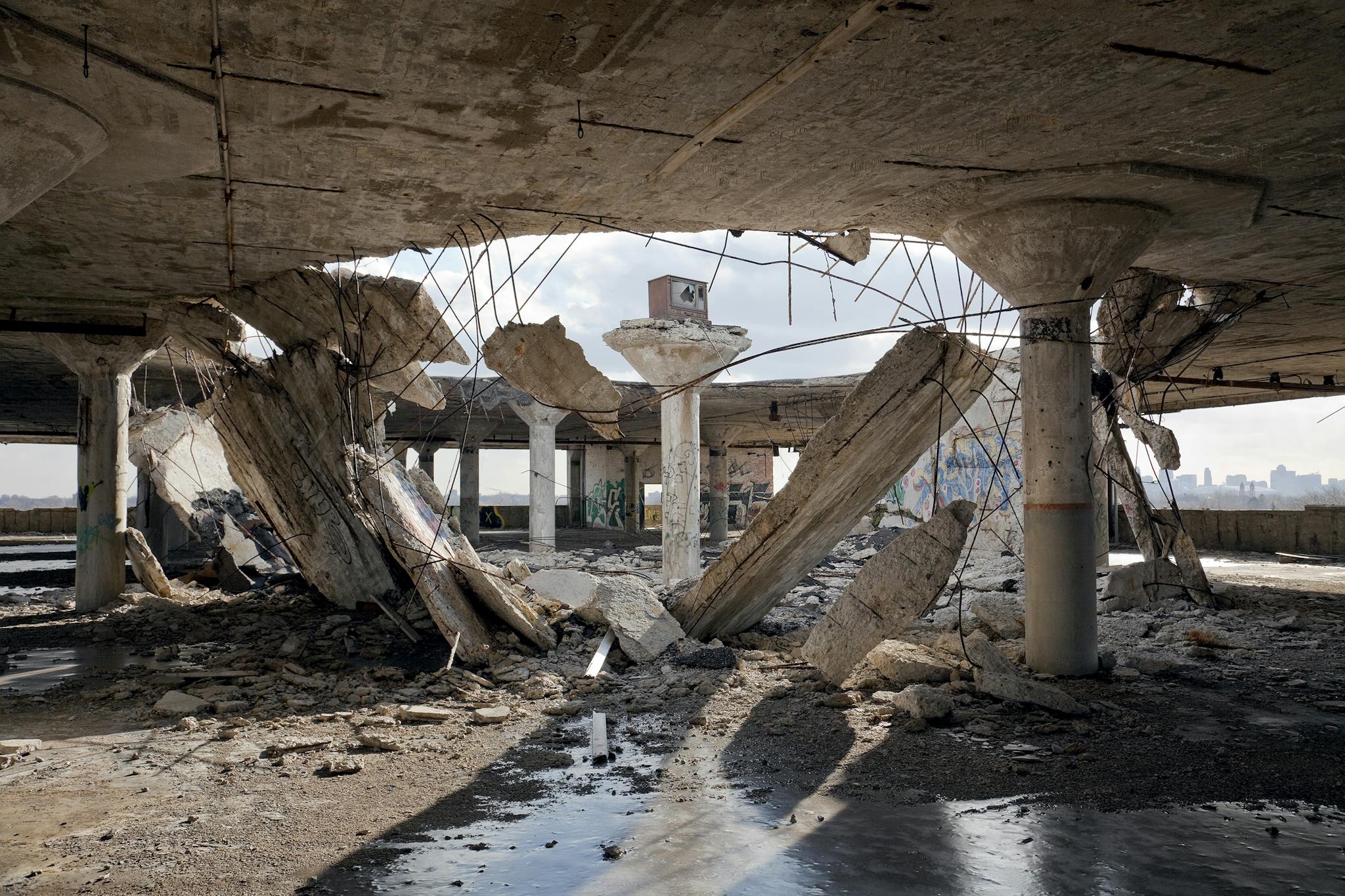
Scott Hocking, Garden of the Gods, Zeus, Ice, 2009. Archival pigment print from the site-specific installation and photography project Garden of the Gods (2009-2011). // This image shows a wooden television atop the pedestal of a lone column in the abandoned Packard automobile complex. It symbolizes Zeus, one of the 12 classical Greek gods referenced in this series.
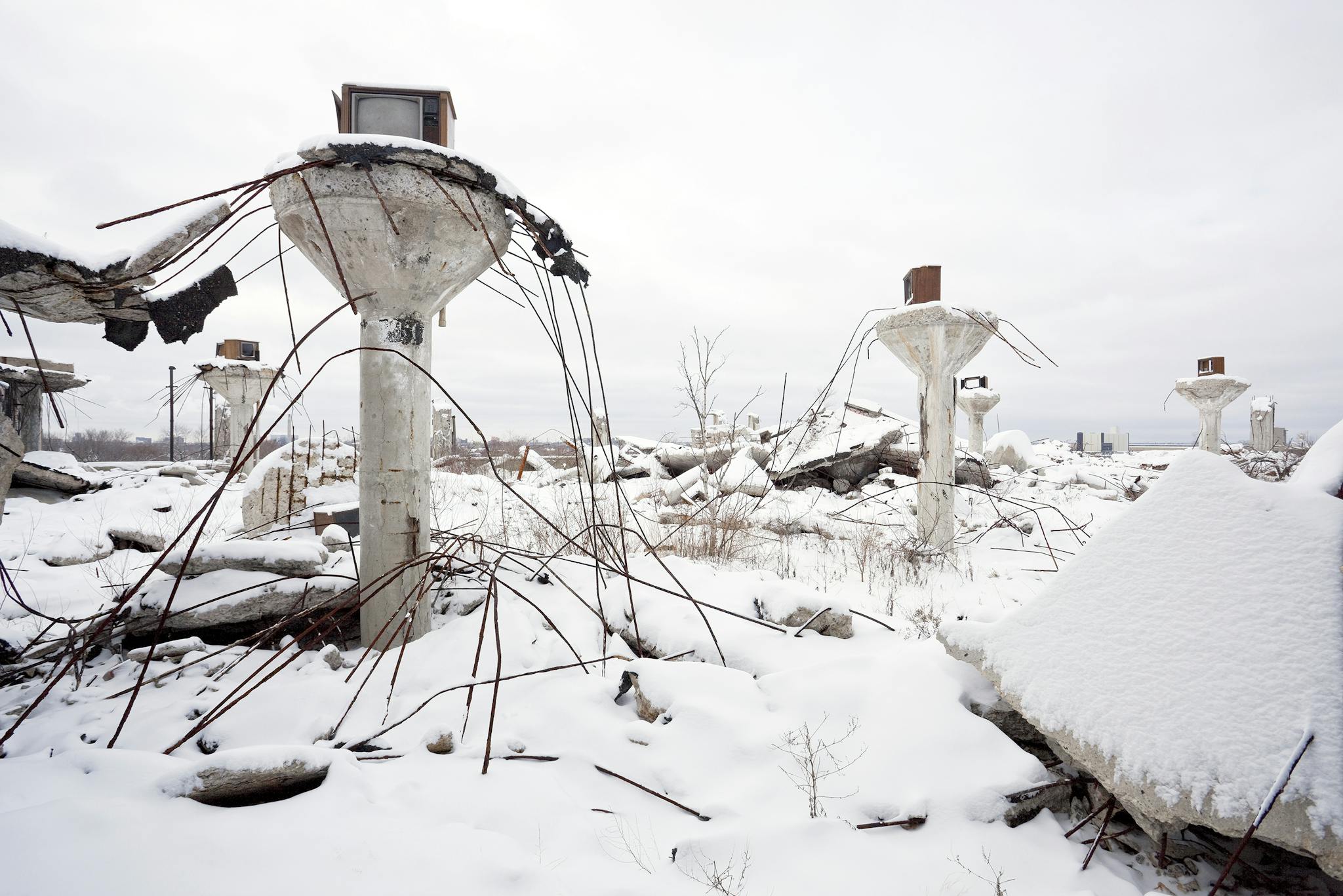
Scott Hocking, Hephaestus and the Garden of the Gods, Snow, 2010. Archival pigment print.
“It was a long period of time before I felt worthy to do an installation in these buildings without the work being insignificant compared to the buildings themselves,” he said. “I was blown away by the layers of history, the way nature had infiltrated and quickly began to take them apart, and how I could be so isolated in these monster spaces—on a roof, in a basement, totally alone for hours—they became like solaces to me, a bit like my churches, where I would find peace and quietude. The train station was one of my favorites—big surprise.”
Hocking’s work often takes a farther look back, recontextualizing traditional sites and structures of ceremony and ritual, such as pyramids, earth mounds, henges, and cairns, within Detroit’s historic landmarks. “The project is based on the ancient symbolic meanings of the egg, as well as stacked stones that can be found worldwide [cairns],” Hocking wrote. “The form of an egg has traditionally represented the unborn potential yet to be hatched; the new beginning; the gestating idea; the primordial matter; creation. Cairns have been used as markers of tombs, caves, or pathways; places of significance; astronomical and navigational tools; and points of mystical or religious importance.”
There is a deeply layered, yet playful, tension between the grandiose sites, the ruin, the cyclical decay and regrowth, and the structures that Hocking constructs within them. “As a part of my art practice I am interested in how our ruins, our relics, our artifacts, will be interpreted and perceived by future people. I’m kind of playing with the idea of what ceremony is, which you can see in a lot of my work where I make these pseudo ceremonial sites, pseudo worship sites, pseudo archaeological digs,” he said.
Hocking’s work aims to create a conceptual conflation of past, present, and future peoples, sites, art, and rituals, in both a humorous and a serious tone. It will always be current. Physically, the deterioration of the structures is a part of its story, which lives on in photographs. Conceptually, it’s rooted across time. “The Egg and Michigan Central Train Station” is forever.
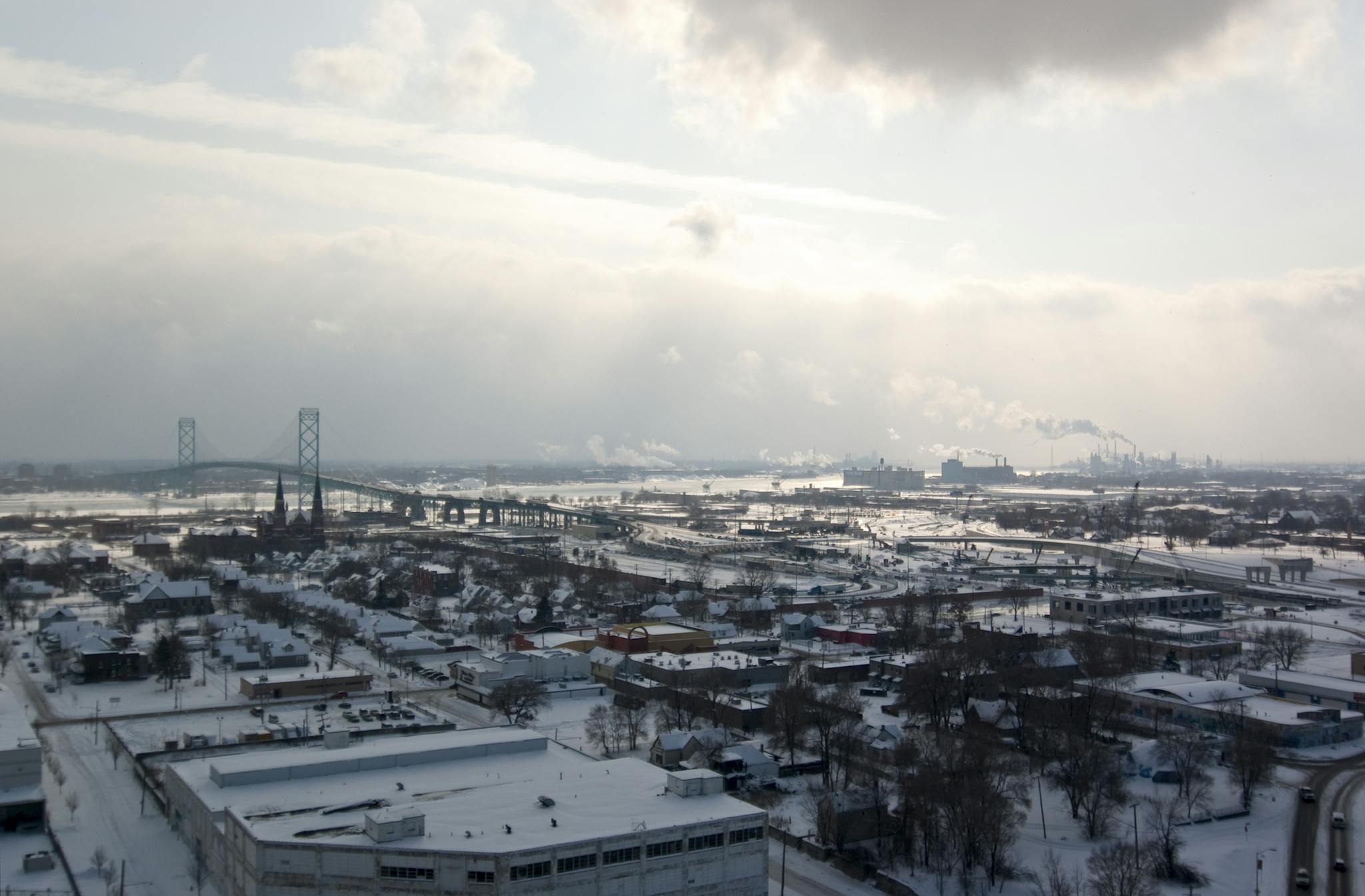
Scott Hocking, The Egg and Michigan Central Train Station #0064, Southwest from Roof, 2009. Archival pigment print. // A view of SW Detroit from the train station roof captures the Ambassador Bridge to Canada, the Detroit River, and the steam-billowing industrial complexes of Zug Island and the Rouge River.
This piece was originally published in Boston Art Review Magazine, Issue 02: Field Work in Fall, 2018.
Scott Hocking’s childhood nickname was Scooter. He grew up on a dirt road, near a railroad track, with a dog named Bubba, who sometimes slept on the kitchen table. He’s a sixth generation Detroiter, descended from Baltic Polish immigrants and a long line of Cornish copper miners who settled in Michigan’s Upper Peninsula. Hocking creates site-specific installations, sculptures and photography projects, often using found materials and neglected locations. Inspired by subjects ranging from ancient mythologies to current events, his artworks focus on transformation, ephemerality, chance, and the cycles of nature. His artwork has been exhibited internationally and nationally, including the Kunst-Werke Institute, the French Triennial Lille 3000: Renaissance, the Museum of Contemporary Art Chicago, The Mattress Factory Art Museum, the Detroit Institute of Arts, and the Eli and Edythe Broad Museum at MSU.
Isabella Achenbach is an independent curator, curatorial affairs manager (Cranbrook Art Museum), Spanish language practitioner and beach aficionado from Washington, DC, currently living in Detroit, Michigan. Her latest research involves curatorial approaches to digital media art, social media as an exhibition space, pre-internet music video culture, and, broadly, contemporary art of the Americas. She recently curated The Sister Show (The Hosting, Ann Arbor) and Personal Space (Public Pool, Detroit), and co-founded a Detroit-based pop-up gallery called Girl Girl Girl, where she curated Olayami Dabls: A Flickr Retrospective.
